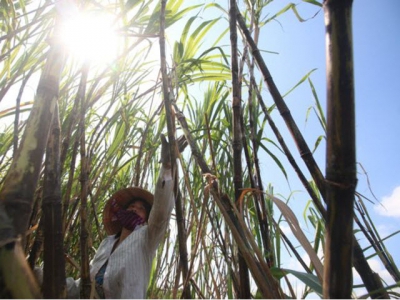Opportunities await sugarcane farmers if they change their way of thinking

HÀ NỘI — While many people believe that sugarcane farmers will face difficulties after Việt Nam implements the ASEAN Trade In Goods Agreement (ATIGA), there are also some who say it could offer bright prospects for Vietnamese sugarcane to maximise its economic value if there is co-ordination between the State, scientists, entrepreneurs and especially farmers.
Harvesting sugarcane in Hậu Giang Province. – VNA/VNS Photo Duy Khương
Professor Võ Tòng Xuân, a top agricultural expert, said that if it was invested and exploited thoroughly, sugarcane could bring high economic value for Vietnamese farmers and businesses.
The State has been pushing solutions to support farmers in recent years, including providing funding for scientists to research and provide new sugarcane varieties for farmers, and to guide scientific cultivation to improve sugarcane productivity.
Sugarcane had many advantages and high economic value, the Đầu Tư Chứng Khoán (Securities Investment) magazine quoted the professor as saying.
At the same time, the State, scientists and entrepreneurs had been creating conditions for the development of sugarcane, he said.
Farmers should change the way of their thinking about growing sugarcane, apply the correct technical processes for selecting varieties, soil and fertiliser, while increasing links with businesses to improve sugarcane productivity and reduce production costs, he said.
Sugarcane was an important industrial crop, providing the main raw material for sugar production, an essential necessity in daily life, and at the same time contributing to poverty alleviation in many rural areas, added the professor.
The country's sugarcane plantations cover 270,000 hectares, with average sugar output reaching 1.3-1.5 million tonnes per year, creating livelihoods for over 35,000 farming households.
Sugarcane had many advantages over other short-term crops, said Xuân.
In terms of biology, sugarcane is widely adaptable and easy to cultivate, with good resistance to harsh natural conditions and environments. It also has the ability to regenerate, helping to reduce production costs.
In term of industry, sugarcane is a multipurpose tree, with possible economic benefits from root to top. Sugarcane stems can be used for sugar, wine, paper, plywood, pharmaceutical and electricity production.
Sugar cane tops and leaves can be used as green manure. In particular, the development of commercial electricity from bagasse is considered to have great potential, as currently biomass electricity only reaches about 26.5 per cent of the development target.
On the other hand, according to OECD-FAO forecasts, domestic sugar consumption in Việt Nam would increase by 5 per cent to about 1.8 million tonnes by 2023.
Có thể bạn quan tâm
 Early autumn-winter rice in Mekong Delta gives high margins
Early autumn-winter rice in Mekong Delta gives high margins During these days, farmers in some provinces in the Mekong Delta have started to harvest early winter-autumn rice with the joy of a bumper crop and high prices.
 Vietnam’s Jan-Sept coffee exports drop 1.4%, rice down 0.6%
Vietnam’s Jan-Sept coffee exports drop 1.4%, rice down 0.6% Vietnam's coffee exports in the first nine months of this year are expected to show a 1.4% drop from a year earlier to 1.25 million tonnes
 Agricultural sector needs impulse for sustainable development
Agricultural sector needs impulse for sustainable development For many years, the production of key agricultural products in the Central Highlands, such as coffee, black pepper, rubber, vegetables, and flowers